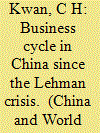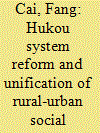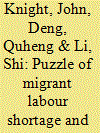|
|
|
Sort Order |
|
|
|
Items / Page
|
|
|
|
|
|
|
| Srl | Item |
| 1 |
ID:
122943


|
|
|
|
|
| Publication |
2013.
|
| Summary/Abstract |
The major objectives of China's macroeconomic policy are to stabilize economic growth and inflation, which, in turn, are important factors determining key prices, such as the policy interest rate, the renminbi exchange rate and stock prices. In a framework that distinguishes different phases of the business cycle based on whether the current period's economic growth rate and inflation rate are above or below their "normal" values, this paper analyzes the interaction among macroeconomic policy, economic growth and inflation in China since the Lehman crisis, and the implications for these key prices. The path of China's economy indicates that stimulus measures taken by the government during the recession phase and tightening measures implemented during the overheating phase have helped minimize the fluctuation over the business cycle. Our analysis shows that Chinese authorities tend to rely more on adjusting the exchange rate than the interest rate to stabilize the economy. Comparing with conditions at the time of the post-Lehman recession, the current slow pace of economic growth in China may reflect not only weakening demand, but also a lower potential growth rate associated with the arrival of the Lewis turning point.
|
|
|
|
|
|
|
|
|
|
|
|
|
|
|
|
| 2 |
ID:
105072


|
|
|
|
|
| Publication |
2011.
|
| Summary/Abstract |
Using a political economy analytical framework, the present paper examines the hukou system reform in China. The potential unification of the social welfare system of rural and urban areas is discussed. The paper reviews the progress of hukou system reform since 2004. It is suggested that since China met its Lewis turning point in about 2004, and a labor shortage became a limiting factor in production, there has been stronger demand for hukou system reform. In the meantime, various levels of government have a point where incentives are compatibile for carrying out reforms. The paper also explores some limitations of the currently implemented reform in certain regions and puts forward relevant policy suggestions.
|
|
|
|
|
|
|
|
|
|
|
|
|
|
|
|
| 3 |
ID:
110506


|
|
|
|
|
| Publication |
2011.
|
| Summary/Abstract |
This paper assesses the applicability of two alternative theories in understanding labor market developments in China: the classical view featuring a Lewis turning point in wage growth versus a neoclassical framework emphasizing rational choices of individuals and equilibrating forces of the market. Empirical evidence based on multiple data sources fails to validate the arrival of the Lewis turning point in China, showing continuous and coordinated wage growth across rural and urban sectors instead. Consistent with the neoclassical view, we find that rural workers expanded off-farm work when mobility restrictions were lifted, interprovincial migration responded to expected earnings and local employment conditions, and returns to education converged gradually to the international standard. These findings suggest major progresses in the integration of labor markets in China.
|
|
|
|
|
|
|
|
|
|
|
|
|
|
|
|
| 4 |
ID:
159040


|
|
|
|
|
| Summary/Abstract |
Despite small landholdings, a high degree of land fragmentation, and rising labor costs, agricultural production in China has steadily increased. If one treats the farm household as the unit of analysis, it would be difficult to explain the conundrum. When seeing agricultural production from the lens of the division of labor, the puzzle can be easily solved. In response to rising labor costs, farmers outsource some power-intensive stages of production, such as harvesting, to specialized mechanization service providers, which are often clustered in a few counties and travel throughout the country to provide harvesting services at competitive prices. Through such an arrangement, smallholder farmers can stay viable in agricultural production.
|
|
|
|
|
|
|
|
|
|
|
|
|
|
|
|
| 5 |
ID:
110504


|
|
|
|
|
| Publication |
2011.
|
| Summary/Abstract |
The paper examines the contentious issue of the extent of surplus labour that remains in China. China was an extreme example of a surplus labour economy, but the rapid economic growth during the period of economic reform requires a reassessment of whether the second stage of the Lewis model has been reached or is imminent. The literature is inconclusive. On the one hand, there are reports of migrant labour scarcity and rising migrant wages; on the other hand, estimates suggest that a considerable pool of relatively unskilled labour is still available in the rural sector. Yet the answer has far-reaching developmental and distributional implications. After reviewing the literature, the paper uses the 2002 and 2007 national household surveys of the Chinese Academy of Social Sciences to analyse and explain migrant wage behaviour, to predict the determinants of migration, and to examine the size and nature of the pool of potential rural-urban migrants. An attempt is also made to project the rural and urban labour force and migration forward to 2020, on the basis of the 2005 1% Population Survey. The paper concludes that for institutional reasons both phenomena are likely to coexist at present and for some time in the future.
|
|
|
|
|
|
|
|
|
|
|
|
|
|
|
|
| 6 |
ID:
158900


|
|
|
|
|
| Summary/Abstract |
There is no convincing evidence to prove that China's Lewis turning point (LTP) arrived in 2004–2005, as suggested in some of the existing literature. Employing data from the National Bureau of Statistics of China for 70,000 rural households and following the method proposed by Minami (1968) to identify the Lewis turning point in Japan, the present study reassessed the reaching of the LTP in China and found that China's economy reached the LTP around 2010. From a regional perspective, China's eastern region reached the LTP in 2010 and its central and western regions are now approaching the turning point. After arriving at the LTP, China's rural economy will face three key tasks: safeguarding grain security, promoting economic restructuring and realizing agricultural modernization. To cope with the shortage of human capital in agriculture production and the challenge of the tight balance between grain supply and demand, the Chinese Government should improve the human capital training system, accelerate agricultural modernization and guarantee national grain security.
|
|
|
|
|
|
|
|
|
|
|
|
|
|
|
|
| 7 |
ID:
161820


|
|
|
|
|
| Summary/Abstract |
Official data are criticized for over-reported agricultural labour statistics. We derive an alternative series of labour participated in agriculture with the information of production cost and revenue. Using parametric stochastic frontier approach, labour requirement functions are estimated for 30 farm and animal husbandry products in rural China. The estimated required amount of labour is compared with our newly-derived observed agricultural labour to obtain the surplus labour. This surplus ranges from 18% to 12% of agricultural labour between 2001 and 2013. Our results reveal that China was relatively successful in reducing redundant labour in rice production. Equally important, the trends of our estimated surplus place China in the second stage of transition under the Lewis-Fei-Ranis framework, moving in the direction of full commercialization or the so-called Lewis turning point.
|
|
|
|
|
|
|
|
|
|
|
|
|
|
|
|
| 8 |
ID:
117919


|
|
|
|
|
| Publication |
2013.
|
| Summary/Abstract |
It has been widely recognised that China has had a large pool of surplus labour. However, despite its significant implications for wage levels and the Chinese economy, the current debates yield conflicting results as to whether a Lewis turning point has been reached. This paper clarifies a theoretical issue about the mechanisms of surplus labour absorption, subsequently indentifies two Lewis turning points and examines the factors that affect the reaching of these two points. It then applies the framework to China to study the labour absorption process and examines some of the likely implications of the removal of the Hukou system in terms of welfare and economic performance.
|
|
|
|
|
|
|
|
|
|
|
|
|
|
|
|
| 9 |
ID:
110505


|
|
|
|
|
| Publication |
2011.
|
| Summary/Abstract |
We examine the wage trends of ordinary workers and the wage convergence between unskilled and skilled workers in China. First, we find that wages in all non-agricultural sectors, wages of migrant workers, and wages of hired workers in the agricultural sector have increased dramatically since 2003. Second, through comparing wage differentials between migrant and urban resident workers and between heterogeneous education groups within migrant workers, and by investigating the changes in the contribution of the returns to education to wage differentials, we find that the wages of unskilled and skilled workers have converged. Both the increasing wage trends and wage convergence are interpreted as evidence supporting the hypothesis that China has passed what can be called the Lewis turning point in the industrial sector. We conclude that the sustainability of economic growth in China requires an upgrading of labor market institutions to accommodate the merging of the rural and urban labor forces.
|
|
|
|
|
|
|
|
|
|
|
|
|
|
|
|
|
|
|
|
|